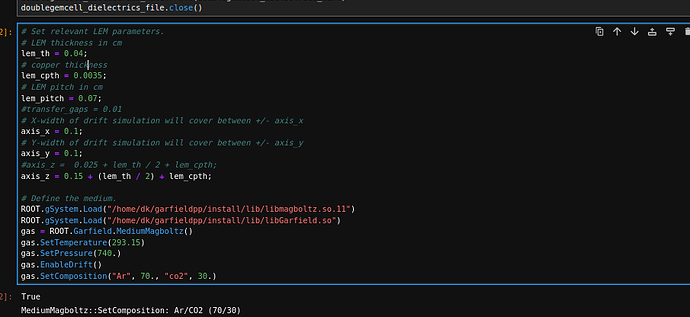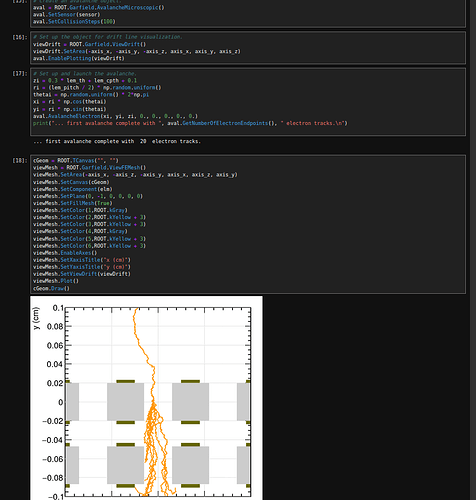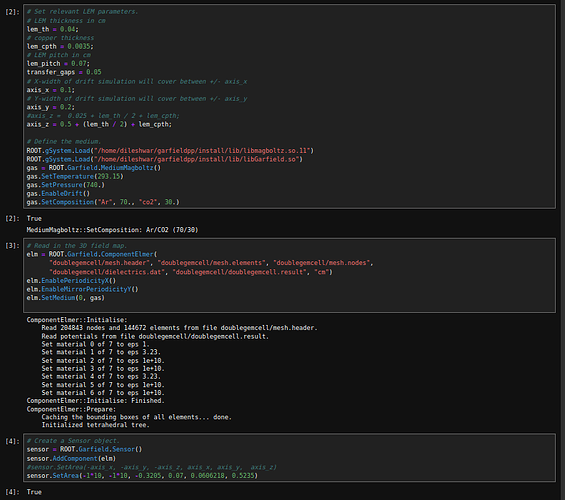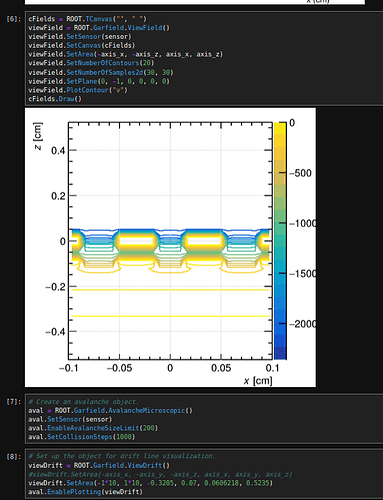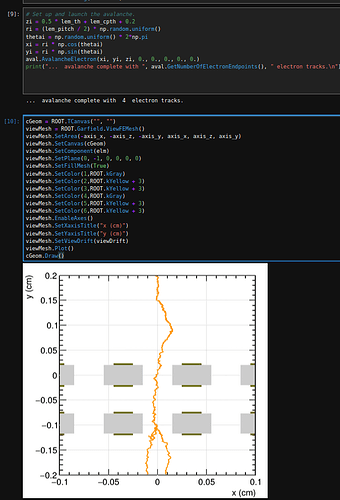hii everyone, i have successfully made 2nd layer(1st and 2nd) gem detector. also calculate electric field but when i look at plot it only avalanche in 1st layer, can you please suggest me , how i avalanche in 2nd layer using endpoints of 1st layer avalanche electron. you can also check my code
Hi,
looking at the plot, the electrons do seem to be transported also through the second GEM layer, no? To get (more) multiplication in the second GEM, you’ll probably need to change the voltage settings.
PS: the two GEM layers seem unusually close to each other; is that intentional?
yes @hschindl sir,
the two GEM layers seem unusually close to each other and that is intentional, means the upper electrode t0to 1st GEM layer 0.3cm and distance b/w 1st and 2nd GEM layers is 0.02cm and lower 2nd lower gem to lower electrode is 0.2cm. Is distance b/w GEMs layer (1st and 2nd) need to change? While GEM parameters is
GEM thickness in cm
lem_th = 0.04;
copper thickness
lem_cpth = 0.0035;
GEM pitch in cm
lem_pitch = 0.07;
X-width of drift simulation will cover between +/- axis_x
axis_x = 0.1;
Y-width of drift simulation will cover between +/- axis_y
axis_y = 0.1;
axis_z = 0.15 + (lem_th / 2) + lem_cpth;
or need any correction in parameters section?
and i have attached my doublegemcell.sif can you check this?
doublegemcell.sif.txt (3.5 KB)
Looking at the screenshot in your previous post, it seems that this is indeed the geometry that you implemented. But why do you put the two GEM layers so close together?
Continuing the discussion from Avalanche problem on double layer(1st and 2nd) GEM detector:
Hlw @hschindl Sir, i increased the distance between both layer but in 2nd layer avalanche is not happening. can you tell me my avalanche setup is correct or need to any requirement. Is me require to avalanche setup in 2nd GEM for avalanche in 2nd GEM
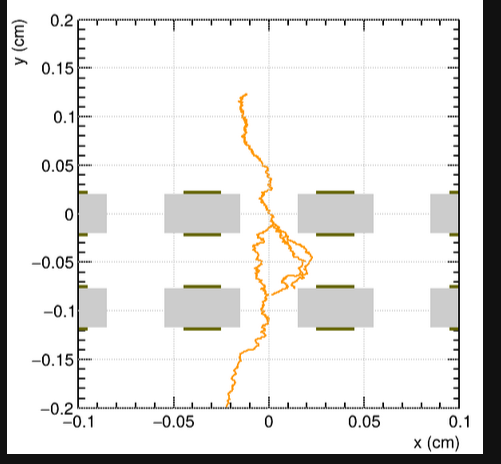
please give some suggestions how avalanche in 2nd GEM using coming from 1st GEM electron.
Dear @Dk_ntm
I see from your sif file that you have 850V of potential difference on your 2nd Thick-GEM and 1250V difference on your 1st Thick-GEM. From your figure I deduce your GEM thickness is 0.5mm, this would lead to a field of 17kV/cm in your 2nd GEM and 25kV/cm in your 1st GEM. In Ar:CO2 70:30 this would be enough to see amplification in both GEMs. Moreover if you have defined the active area of your sensor correctly (it comprises both GEMs plus all gaps), then the avalanche will be calculated in the entire active area, no need to pass ‘manually’ from one GEM to another.
Few questions:
- Can you run more than one event? Maybe repeat 10 times. Because 1 event is not statistically significant to make those claims. As a next step can you eventually count the number of electrons at the end of GEM1 and at the end of GEM2 and make a histogram?
- Can you make a plot of your potential map and your electric field map in the sensor?
greets
Piet
dear @Piet sir, each GEM dielectric thickness 0.4mm = 0.04cm and this distance between GEM both GEMs is 0.5mm =0.05cm . Sir, can you plz explain me why are not happen avalanche in 2nd GEM. According to your, i need to change in active area? can you suggest some examples
Thank you sir!
My double layer GEM detector value is
BOUNDING BOX
X-coordinate: [ 0 , 0.07 ]
Y-coordinate: [ 0 , 0.0606218 ]
Z-coordinate: [ -0.3205 , 0.5235 ]
First, tell me how many avalanches have you generated? As this is a statistical process it can happen that you are unlucky and you have a downward fluctuation if you run only 1 avalanche. Did you run 10 avalanches and all were without amplification in the 2nd Gem?
If that is the case, then we need to be sure about the electric field. Please make the potential and electric field map in your detector, to make sure you have a field that is high enough for multiplication.
dear @Piet , @hschindl sir, When i change the sensor(SetArea) according to BOUNDING BOX of double layer gem geometry
X-coordinate: [ 0 , 0.07 ]
Y-coordinate: [ 0 , 0.0606218 ]
Z-coordinate: [ -0.3205 , 0.5235 ]
it works means i found that both gem performing with minimum avalanche, when single electron randomly initiate into double layer thick gem with 0 energy. i have attached the screenshot. can you suggest me how perform more avalanche. please check my code particularly sensor area and avalanche setup, Is i correctly define sensor area and avalanche setup parameters for both gem.
Thank you for your support and understanding ![]()
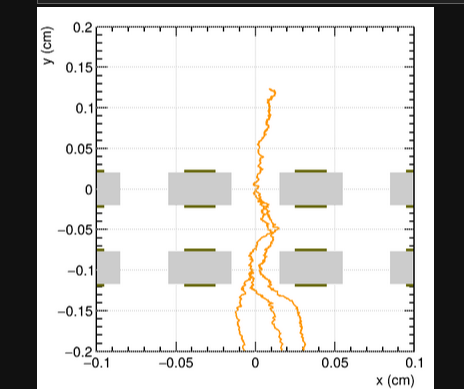
Dear @Dk_ntm your sensor area should correspond to the entire volume you would like to simulate the charge transport. As you have defined these values in the beginning of your code, you should adopt these also here:
sensor.SetArea(-axis_x, -axis_y, -axis_z, axis_x, axis_y, axis_z)
I do not understand what you mean with your “BOUNDING BOX”. Probably it does not matter as long as you set correctly the area/volume of your sensor.
For what concerns your question
can you suggest me how perform more avalanche.
You would need to change (increase) the voltage difference between the top and bottom of the GEM foils to obtain a higher gain in your detector.
dear @Piet when adopt these lines
sensor.SetArea(-axis_x, -axis_y, -axis_z, axis_x, axis_y, axis_z)
avalanche performing in 1st Gem but not happening in 2nd Gem.
can you tell me how i choose sensor active area for both Gem, basically i’m beginner in this field sir.
Thank you for your precious time and support. i’m always grateful to you.
Sorry, I can’t see where you have defined axis_x, axis_y, axis_z. Can you give me their values?
These are the values sir!
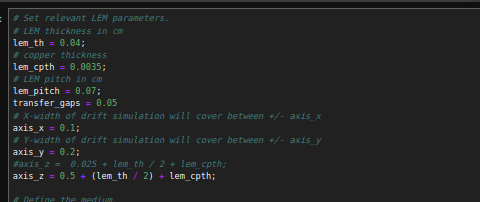
Thank you @Piet sir it’s working. i’m always grateful to you ![]()
This topic was automatically closed 14 days after the last reply. New replies are no longer allowed.
